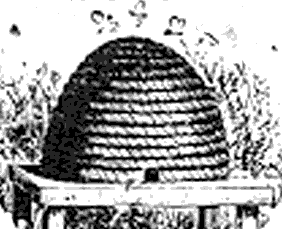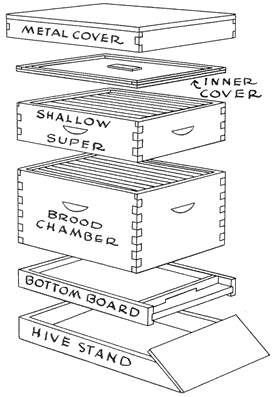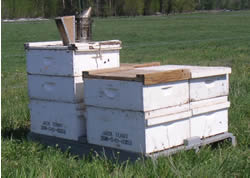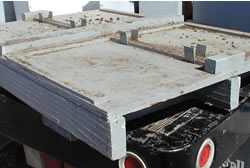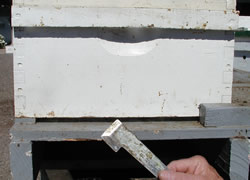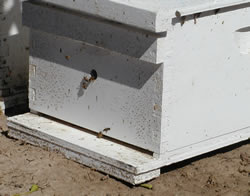|
VARIATIONS ABOUND:
The hive description
so far is ideal for a hobby beekeeper who has several hives that may sit
in the back yard year round. The system described above is the classic
Langstroth ten frame hive system.
Because of time constraints
and the need to constantly move hives, the commercial bee person does
without some of the parts and pieces of the classic hive configuration.
Out of necessity the ideal is reduced to a practical manageable compromise
in a commercial operation. How this compromise is made can be the subject
of endless discussion when beekeepers talk shop, but here's one approach.
Arranging the hives
on pallets and the use of a fork lift addresses the efficient movement
of the hives when necessary. Both four and six hive per pallet arrangements
are common - our pallet setup is shown at right (fig 3, 4 & 5).
While the reversible
bottom board is a good solution for changing the entrance with the season,
we settle for a 3/8" entrance year round and use a tapered wooden
(wedge type) entrance reducer in the winter or at other times of the year
when bees from other hives may be robbing.
The lids we use are
made of plywood with two end cleats - no inner cover. There isn't much
opportunity to feed bees during the winter, so we concentrate on having
enough honey (weight) on the hives to make it through the winter without
additional feeding. A small grove in the lid provides a small top entrance
as well as some ventilation.
The pallet arraignment
provides a combination bottom board and hive stand for all four hives.
The three 2x4s going the long way have two 1x6 cleats across the bottom
that take the worst of the ground moisture and somewhat protect the rest
of the pallet from moisture. The boxes simply sit on the pallet and are
captured by the metal clips for side to side stability and wood cleats
at front and rear (fig 4). Additional boxes are simply stacked on top
without any means of capturing one box to the other. Eventually the bees
"glue" the boxes together but before this happens, hives are
difficult to move and keep the boxes stacked together.
For single hives
(normally splits) we use a bottom board attached to the deep box with
screws. For single hives it is desirable to attach the bottom board to
the hive body so the hive can be picked up and everything stays together.
See April for a description of how splits are
made.
Notice the hand cleats
on all the deep boxes which provide a place to grab hold of the hive or
box. These are a great aid in lifting the hive and work much better than
the hand recesses cut into the boxes by some manufacturers.
Once the hive out
grows the single deep box the bottom board (attached with screws) comes
off and the hive goes on a pallet before another box is added. Lifting
a two story single hive isn't something you look forward to, so when they
need a second box they go on a pallet. The same lid is used for single
hives as those on pallets.
|
